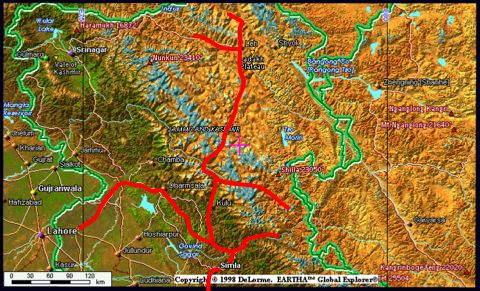![]()
INDIA : Delhi to Amritsar
|
|
INDIA : Delhi to Amritsar |

| Delhi to Amritsar |
| Driving north from Delhi we
headed to Himachal Pradesh and the city of Shimla. The famous hill station
of Shimla like that of Darjeeling or McLeod was used by the British to
escape from the stifling heat of the Indian plains. After Shimla, we
headed East on the Indo-Tibet road. Our aim was to make the round trip and
visit the Spiti valley but we had to return the same way as the road was
closed. We headed north to Ladakh and its capital Leh. From Leh, altitude
3500 m, we roamed West (to Lamayuru) and North (to the Nubra Valley)
before heading south using the same Manali-Leh road. On our way down we
turned left to visit the Spiti valley we had not been able to visit 2
weeks earlier. In Himachal Pradesh, we headed to Dharamsala, home of the
Dalai Lama and the Tibetan Government in exile then into the plains of
Punjab and Amritsar which lies 26 km from the only INDO-PAK border open to
foreigners.
|
| Himachal Pradesh |
| The State of Himachal Pradesh lies north of Delhi and West of Nepal. As we had experienced with Sikkim, which lies to the East of Nepal, the Indian plain will all of a sudden meet the green lush hills. Coming from the desert of Rajasthan and dusty Indian cities, this was a welcome change. Himachal Pradesh is famous in India for its production of apples and apple juice and the countryside is often one large orchard. |
|
|
| If the nature was similar to
Sikkim though not as rich, many buildings in Himachal Pradesh have a most
peculiar and distinctive architecture. It reminded us of Swiss chalets :
the combined use of stone and large wooden beams. In this part of the
world, the wooden beams are also meant to protect the building against
earthquakes.
|
|
|
|
Bhimakali temple, 13th century, Sarahan, Himachal Pradesh, India
|
| Because of the altitude and
lower temperature, Himachal Pradesh is also where we started to sleep in
our tent again. We had lost the winch to rise our tent in Sikkim 2 months
earlier. Thanks to family (thanks Mum), friends in Delhi (thanks Isabelle
& Tahir) and to a courier (thanks Christine !), we were able to sleep
at home again. What a great feeling to go out camping again !
|
|
|
|
A flower offering on 1920s silver doors, Bhimakali temple, Sarahan, India
|
|
|
|
The green and lush Kullu valley, Himachal Pradesh
|
| The further north we drove
towards Ladakh, nature would become less green. Ladakh is a land of sand
and rocks. It is the boundary between the Western Himalaya and the Tibetan
plateau.
|
|
|
|
|
|
Grand Canyon style scenery, on our way back from Leh (Ladakh) to Manali (Himachal Pradesh).
|
| Road builders from Nepal and
Bihar (India) lead a very rough life. They have only a few months each
year to build or maintain roads and weather conditions and the altitude
must take their toll on their health. 95% of the work is done by hand. The
end of August is the time of year when shepherds lead their sheep and
goats down from Ladakh to Himachal Pradesh and Punjab. We saw little
village children, not much taller than the goats and sheep, run through
these herds and have a lot of fun. The shepherds were not impressed !
|
|
|
| The Spiti Valley |
| On our way down from Ladakh,
we did manage to turn left into the Spiti valley. This valley is known for
its remoteness, stunning mountains and old monasteries. Tabo gompa, the
most famous amongst them, is the monastery where the Dalai Lama has said
he wanted to go to retire. The condition of the road was sometimes so
bad that, on two occasions, we were very lose to turning back but the
scenery made it all worthwhile.
|
|
|
|
|
| Amritsar |
| Amritsar was our last city in
India before crossing over to Pakistan. Capital of Indian Punjab, it is
home to the Golden Temple, centre of Sikh religion. This temple has had a
troubled history, even in the last 10 years as Sikh separatists who had
taken refuge in the temple had to be dislodged by force by the Indian
army. The temple today is a beautiful and peaceful place. We felt it was a
privilege to visit the temple and watch Sikh people go about their
worship. The other historical place we visited was Jallianwala Bagh (right
picture). As shown in the film "Gandhi", this small park was the
scene of a massacre by British troops in 1919.
|
|
|
| Here is the first of our extra pages : |
|
|
| If you need a travel agency
run by a Westerner based in Delhi, contact Isabelle Willemart at :
|
|
|
We are doing well !
| Rajasthan | Back to Trip page | To Pakistan |